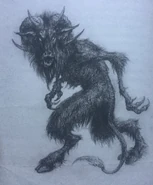Boggarts are spirit creatures of the dark that come in all shapes and sizes and house a multitude of personalities. Boggarts can chose to show themselves to anyone but often stay invisible, but most are still visible to spooks. They can understand human language, but most communicate with actions rather than words. Speech indicates a higher than usual intelligence.
All boggarts use ley lines to travel from one place to another. When mobile, they are known as free boggarts. Occasionally, boggarts are naturally bound by disturbances to the ley lines, which may strand them in one spot. This angers the boggart, and they immediately become disruptive and dangerous.
They are far more numerous in the County than anywhere else on earth. Typically boggarts make their lairs in cellars, barns and hollow trees; most are, at the very least, an inconvenience to people nearby.
There are eight known types of boggarts categorized by spooks.
Classes of boggart[]
Exceptions for boggarts[]
Boggarts can be reasoned with, such as the case of John Gregory’s ‘pet boggart’, Kratch (a hairy boggart) that cooks his meals and defends his garden.
Boggarts that cannot be reasoned with or intimidated are deemed dangerous to humans and are lured into a pit with a milk and/or blood pan at the bottom. The pit is coated in a mixture of salt and iron (salt burns a boggart while iron bleeds away its strength) mixed together with a glue made from bones. The pit is coated on all four walls, floor and ceiling with a custom made stone lid to seal them off (this must be airtight because boggarts can escape from a hole the size of a needle head).
Dealing with unknown boggarts[]
Stage 1: Negotiation[]
The first step is to find out why a boggart is being troublesome and then make it an offer. This can simply be the respect of the people it is plaguing, or even their gratitude. It is in fact possible to live in the same house as a boggart and for the situation to be quite comfortable. Many boggarts respond to flattery.
Stage 2: Intimidation[]
If negotiation fails, then an attempt should be made to intimidate the boggart by making its life in that location uncomfortable or even impossible. Salt and iron may be positioned strategically. Some boggarts strategically. Some boggarts take up residence in old thorn trees or store their power there. The tree may be chopped down or burned, thus forcing the creature to search for a new location. Note that intimidation can often prove to be the most dangerous technique of the four. For, while a spook is annoying the boggart in an attempt to drive it away, the entity is unpredictable and may suddenly resort to extreme violence.
Stage 3: Binding[]
To bind a boggart a spook must first dig a pit and then coat the inside with salt and iron mixed into a bone glue. Next, a lid must be fashioned by a reliable stonemason, then hoisted into position directly above by a skilled rigger. To facilitate this, the mason attaches a hook to the top of the stone, which is later removed. After the underside of the stone has been coated with the mixture, a bait-dish is filled with blood. This lures the boggart into the pit, at which point the stone is quickly lowered into position to bind it there.
Stage 4: Slaying[]
Finally, when all else fails, a boggart must be slain by casting salt and iron at it. It is important to get the timing right. Both substances must be hurled in such as way that they come together at exactly the same moment and envelop the boggart in a lethal cloud. Again, this takes a great deal of practise. Very powerful boggarts who can remain invisible even to spooks are particularly difficult to deal with.
Trivia[]
- In Seventh Son, John Gregory claims that boggarts are afraid of water, and have horrible eyesight, that they rely on smell.
